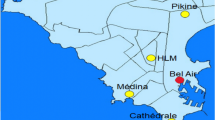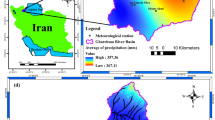Abstract
The stepwise regression model (SRM) is a widely used statistical downscaling method that could be used to establish a statistical relationship between observed precipitation and predictors. However, the SRM cannot reflect the contributions of predictors to precipitation reasonably, which may not be the best model based on several possible competing predictors. Bayesian model averaging (BMA) is a standard inferencing approach that considers multiple competing statistical models. The BMA infers precipitation predictions by weighing individual predictors based on their probabilistic likelihood measures over the training period, with the better-performing predictions receiving higher weights than the worse-performing ones. Furthermore, the BMA provides a more reliable description of all the predictors than the SRM, leading to a sharper and better calibrated probability density function (PDF) for the probabilistic predictions. In this study, monthly precipitation at fifteen meteorological stations over the period of 1971–2012 in the Heihe River basin (HRB), which is located in an arid area of Northwest China, was simulated using the Bayesian model averaging (BMA) and the stepwise regression model (SRM), which was then compared with the observed datasets (OBS). The results showed that the BMA produced more accurate results than the SRM when used to statistically downscale large-scale variables. The multiyear mean precipitation results for twelve of the fifteen meteorological stations that were simulated by the BMA were better than those simulated by the SRM. The RMSE and MAE of the BMA for each station were lower than those of the SRM. The BMA had a lower mean RMSE (− 13.93%) and mean MAE (− 14.37%) compared with the SRM. The BMA could reduce the RMSEs and MAEs of precipitation and improve the correlation coefficient effectively. This indicates that the monthly precipitation simulated by the BMA has better consistency with the observed values.





Similar content being viewed by others
References
Campozano L, Tenelanda D, Sanchez E, Samaniego E, Feyen J (2016) Comparison of statistical downscaling methods for monthly total precipitation: case study for the Paute River basin in Southern Ecuador. Adv Meteorol 2016:6526341–6526313. https://doi.org/10.1155/2016/6526341
Cheng GD, Xiao HL, Xu ZM et al (2006) Water issue and its countermeasure in the inland river basin of Northwest China (in Chinese). J Glaciol Geocryol 28:406–413
Cheng CS, Li GL, Li Q, Auld H (2011) A synoptic weather-typing approach to project future daily rainfall and extremes at local scale in Ontario, Canada. J Clim 24:3667–3685. https://doi.org/10.1175/2011JCLI3764.1
Duan QY, Ajami NK, Gao X, Sorooshian S (2007) Multi-model ensemble hydrologic prediction using Bayesian model averaging. Adv Water Resour 30:1371–1386. https://doi.org/10.1016/j.advwatres.2006.11.014
Fatichi S, Ivanov VY, Caporali E (2011) Simulation of future climate scenarios with a weather generator. Adv Water Resour 34:448–467. https://doi.org/10.1016/j.advwatres.2010.12.013
Fatichi S, Ivanov VY (2013) Assessment of a stochastic downscaling methodology in generating an ensemble of hourly future climate time series. Climate Dynamics 40:1841–1861
Hay LE, McCabe GJ, Wolock DM, Ayers MA (1991) Simulation of precipitation by weather type analysis. Water Resour Res 27:493–501. https://doi.org/10.1029/90WR02650
Hoeting JA, Madigan D, Raftery AE, Volinsky CT (1999) Bayesian model averaging: A tutorial (with discussion). Stat Sci 14:382–401
Huang J, Zhang JC, Zhang ZX (2012) Simulation of extreme precipitation indices in the Yangtze River basin by using statistical downscaling method (SDSM). Theor Appl Climatol 108:325–343. https://doi.org/10.1007/s00704-011-0536-3
Huth R (1999) Statistical downscaling in central Europe: evaluation of methods and potential predictors. Clim Res 13:91–101. https://doi.org/10.3354/cr013091
Kalnay E, Kanamitsu M, Kistler R, Collins W, Deaven D, Gandin L, Iredell M, Saha S, White G, Woollen J (1996) The NCEP/NCAR 40-year reanalysis project. Bull Am Meteorol Soc 77:437–471. https://doi.org/10.1175/1520-0477(1996)077<0437:TNYRP>2.0.CO;2
Kannan S, Ghosh S (2010) Prediction of daily rainfall state in a river basin using statistical downscaling from GCM output. Stoch Env Res Risk A 25:457–474. https://doi.org/10.1007/s00477-010-0415-y
Kass RT, Raftery AE (1995) Bayes Factors. J Am Stat Assoc 90:773–795
Kim JW, Chang JT, Baker NL, Wilks DS, Gates WL (1984) The statistical problem of climate inversion-determination of the relationship between local and large-scale climate. Mon Weather Rev 112:2069–2077. https://doi.org/10.1175/1520-0493(1984)112<2069:TSPOCI>2.0.CO;2
Lan YC et al (2005) Change of water resources in mountainous area of Heihe River under global-warming scene (in Chinese). J Desert Res 25:863–868
Leamer EE (1978) Specification Searches. Wiley 370 pp
Li Y, Smith I (2009) A statistical downscaling model for southern Australia winter rainfall. J Clim 22:1142–1158. https://doi.org/10.1175/2008JCLI2160.1
Liu JM, Yuan D, Zhang LP, Zou X, Song XY (2016) Comparison of three statistical downscaling methods and ensemble downscaling method based on Bayesian model averaging in Upper Hanjiang River basin, China. Adv Meteorol 2016:7463963. https://doi.org/10.1155/2016/7463963
Maraun D, Osborn TJ, Rust HW (2011) The influence of synoptic airflow on UK daily precipitation extremes. Part I: observed spatio-temporal relationships. Clim Dyn 36:261–275. https://doi.org/10.1007/s00382-009-0710-9
Murphy JM (1999) An evaluation of statistical and dynamical techniques for downscaling local climate. J Clim 12:2256–2284
Osca J, Romero R, Alonso S (2013) Precipitation projections for Spain by means of a weather typing statistical method. Glob Planet Chang 109:46–63. https://doi.org/10.1016/j.gloplacha.2013.08.001
Raftery AE, Zheng Y (2003) Discussion: performance of Bayesian model averaging. J Am Stat Assoc 98:931–938. https://doi.org/10.1198/016214503000000891
Raftery AE, Gneiting T, Balabdaoui F, Polakowski M (2005) Using Bayesian model averaging to calibrate forecast ensembles. Mon Weather Rev 133:1155–1174. https://doi.org/10.1175/MWR2906.1
Ruping M, Straus DM (2002) Statistical–dynamical seasonal prediction based on principal component regression of GCM ensemble integrations. Mon Weather Rev 130:2167–2178. https://doi.org/10.1175/1520-0493(2002)130<2167:SDSPBO>2.0.CO;2
Sachindra DA, Huang F, Barton A, Perera BJC (2014) Statistical downscaling of general circulation model outputs to precipitation - part 2: bias-correction and future projections. Int Journal Climatol 34:3282–3303
Singh D, Jain SK, Gupta RD (2015) Statistical downscaling and projection of future temperature and precipitation change in middle catchment of Sutlej River basin, India. J Earth Syst Sci 124:843–860. https://doi.org/10.1007/s12040-015-0575-8
Spak S (2007) A comparison of statistical and dynamical downscaling for surface temperature in North America. J Geophys Res 112:D08101. https://doi.org/10.1029/2005JD006712
Su HF, Xiong Z, Yan XD, Dai XD, Wei WG (2016) Comparison of monthly rainfall generated from dynamical and statistical downscaling methods: a case study of the Heihe River basin in China. Theor Appl Climatol 129:437–444. https://doi.org/10.1007/s00704-016-1771-4
Viallefont V, Raftery AE, Richardson S (2001) Variable selection and Bayesian model averaging in case-control studies. Stat Med 20:3215–3230. https://doi.org/10.1002/sim.976.abs
Von Storch H, Zorita E, Cubasch U (1993) Downscaling of global climate change estimate to regional scales: an application to Iberian rainfall in wintertime. J Clim 6:1161–1171. https://doi.org/10.1175/1520-0442(1993)006<1161:DOGCCE>2.0.CO;2
Vrac M, Naveau P (2007) Stochastic downscaling of precipitation: from dry events to heavy rainfalls. Water Resour Res 43:W07402. https://doi.org/10.1029/2006WR005308
Wang L, Ranasinghe R, Maskey S, van Gelder PHAJM, Vrijling JK (2015) Comparison of empirical statistical methods for downscaling daily climate projections from CMIP5 GCMs: a case study of the Huai River basin, China. Int J Climatol 36:145–164. https://doi.org/10.1002/joc.4334
Wilby RL, Wigley TML (1997) Downscaling general circulation model output: a review of methods and limitations. Prog Phys Geogr 21:530–548. https://doi.org/10.1016/S0022-1694(99)00136-5
Wilby R, Hay LE, Leavesley GH (1999) A comparison of downscaled and taw GCM output: implications for climate change scenarios in the San Juan River basin, Colorado. J Hydrol 225:67–91. https://doi.org/10.1016/S0022-1694(99)00136-5
Zhang XL, Yan XD (2015) A new statistical precipitation downscaling method with Bayesian model averaging: a case study in China. Clim Dyn 45:2541–2555. https://doi.org/10.1007/s00382-015-2491-7
Acknowledgments
The authors thank the Environmental and Ecological Science Data Center of Western China, National Natural Science Foundation of China, for providing the meteorological and hydrological observation datasets.
Funding
This study was financially supported by the National Natural Science Foundation of China (Grant No. 91425304 and 51339004) and the Chinese Academy of Sciences Strategic Priority Program (Grant No. XDA05090206).
Author information
Authors and Affiliations
Corresponding author
Additional information
Publisher’s note
Springer Nature remains neutral with regard to jurisdictional claims in published maps and institutional affiliations.
Rights and permissions
About this article
Cite this article
Su, H., Xiong, Z., Yan, X. et al. An evaluation of two statistical downscaling models for downscaling monthly precipitation in the Heihe River basin of China. Theor Appl Climatol 138, 1913–1923 (2019). https://doi.org/10.1007/s00704-019-02925-6
Received:
Accepted:
Published:
Issue Date:
DOI: https://doi.org/10.1007/s00704-019-02925-6




